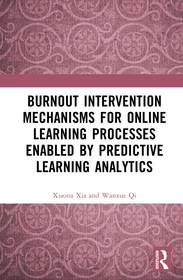
Burnout Intervention Mechanisms for Online Learning Processes Enabled by Predictive Learning Analytics
- Publisher's listprice GBP 145.00
-
69 273 Ft (65 975 Ft + 5% VAT)
The price is estimated because at the time of ordering we do not know what conversion rates will apply to HUF / product currency when the book arrives. In case HUF is weaker, the price increases slightly, in case HUF is stronger, the price goes lower slightly.
- Discount 10% (cc. 6 927 Ft off)
- Discounted price 62 346 Ft (59 378 Ft + 5% VAT)
Subcribe now and take benefit of a favourable price.
Subscribe
69 273 Ft

Availability
Estimated delivery time: In stock at the publisher, but not at Prospero's office. Delivery time approx. 3-5 weeks.
Not in stock at Prospero.
Why don't you give exact delivery time?
Delivery time is estimated on our previous experiences. We give estimations only, because we order from outside Hungary, and the delivery time mainly depends on how quickly the publisher supplies the book. Faster or slower deliveries both happen, but we do our best to supply as quickly as possible.
Product details:
- Edition number 1
- Publisher Routledge
- Date of Publication 30 September 2025
- ISBN 9781041134084
- Binding Hardback
- No. of pages216 pages
- Size 234x156 mm
- Weight 560 g
- Language English
- Illustrations 45 Illustrations, black & white; 45 Line drawings, black & white; 29 Tables, black & white 700
Categories
Short description:
This title aims to fully demonstrate the burnout of students in online learning processes. The authors propose a series of feasible and reliable solutions to sufficiently obtain and analyze massive instances of online learning behavior.
MoreLong description:
This book aims to fully demonstrate the burnout of learners in online learning processes. The authors propose a series of feasible and reliable solutions to sufficiently obtain and analyze massive instances of online learning behavior.
In order to flexibly perceive and intervene in the "burnout state" and improve online learning processes and learning effectiveness, the authors design and construct various novel data analysis models and decision prediction methods using technological means and data-driven learning strategies. Their innovative methods, techniques, and decisions would benefit autonomous learning behavior tracking and stimulate the learning interest of online learning processes enabled by predictive learning analytics. By employing behavioral science research strategies, they build adaptive prediction and optimization measures for positive online learning patterns, improve learning behaviors, optimize learning states, and establish dynamic and sustainable knowledge tracing paths and behavior scheduling methods, enabling users to achieve self-organization and self-mobilization in their overall learning processes.
The book will appeal to scholars and learners in Europe, North America, and Asia, especially those majoring in educational statistics and measurement, educational big data, learning analytics, educational psychology, artificial intelligence in education, computer science, and online collaborative learning.
MoreTable of Contents:
1. Introduction 2. Key Burnout Feature Selection and Association Prediction of Learning Behaviors 3. Learning Behavior Reasoning and Critical Path Fusion for Burnout Based on Multi-entity Association 4. Predicting Burnout States and Guiding Learning Behaviors Driven by Knowledge Graph Propagation 5. Adaptive Positioning of Temporal Intervals for Key Interventions and Burnout Tracking 6. Risk Prediction and Early Warning Routing Formation of Burnout State Propagation 7. Positive Guidance of Learning Behaviors Based on Effective Burnout Intervention 8. Conclusion
More



